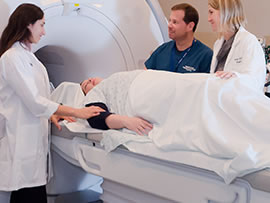CT and MRI Contrast and Kidney Function
The following article was written by Ronald Zagoria, MD, FACR, Professor and Chief of Abdominal Imaging in the UCSF Department of Radiology and Biomedical Imaging.
 As a radiologist at UCSF, I commonly work with patients getting CT and MRI scans. For many of these scans, contrast material is injected intravenously to complete the scan. Contrast agents help radiologists see some details on scans that are not visible otherwise. Contrast agents for both CT and MRI are an extremely safe group of drugs and adverse side effects rarely develop. CT contrast materials do rarely cause kidney damage and a skin disorder called nephrogenic systemic fibrosis (NSF) can be caused by the MRI contrast agents. Patients with poor kidney function are the people at risk for these side effects. In this blog I will discuss the approach to these issues at UCSF. First, we evaluate the scan request for every patient to see if contrast material is needed at all. In many cases a scan without contrast material is adequate for diagnosis. If contrast material will be helpful then we follow a process to make sure that it is safe to inject it.
As a radiologist at UCSF, I commonly work with patients getting CT and MRI scans. For many of these scans, contrast material is injected intravenously to complete the scan. Contrast agents help radiologists see some details on scans that are not visible otherwise. Contrast agents for both CT and MRI are an extremely safe group of drugs and adverse side effects rarely develop. CT contrast materials do rarely cause kidney damage and a skin disorder called nephrogenic systemic fibrosis (NSF) can be caused by the MRI contrast agents. Patients with poor kidney function are the people at risk for these side effects. In this blog I will discuss the approach to these issues at UCSF. First, we evaluate the scan request for every patient to see if contrast material is needed at all. In many cases a scan without contrast material is adequate for diagnosis. If contrast material will be helpful then we follow a process to make sure that it is safe to inject it.
Who needs to have their kidney function checked before being injected with contrast material for a scan?
We know that most patients have normal kidney function and need no precautions, however, not every patient with impaired kidney function will be aware of it. We know that the likelihood of impaired renal function is substantially higher in some people, such as patients over 60 years old and those who have certain illnesses, such as diabetes. At UCSF we use a questionnaire to identify patients who need lab testing before scanning to ensure that it’s safe to inject the contrast material. Every patient will be asked a series of questions that help us determine which patients do not need laboratory testing to measure their kidney function. The questionnaire has been proven to be a simple and reliable way to identify those people at risk of having renal problems and avoiding the need to get blood tests on all patients.
What lab values indicate a need for concern when contrast material is injected?
Historically serum creatinine was the lab value used to assess kidney function. A better and more accurate measure is a lab result called estimated glomerular filtration rate (eGFR). eGFR takes into account the serum creatinine value and also patient age, race and gender which affect kidney function results. At UCSF we use this very accurate blood test to assess kidney function and it can be obtained quickly, right before a scan. For CT, eGFR > 45 indicates no increased risk of kidney damage from contrast material. eGFR > 30, but less than 45 indicates that while it is safe to get contrast material, there is a small risk of causing kidney damage. In that situation, we will inject additional fluid into the patient’s vein before and after the contrast material injection. This hydration is effective to prevent any renal damage. For MRI, it is safe to give a regular dose of contrast material as long as the patient’s eGFR is > 30.
Why does kidney function matter and what is the risk of the contrast material causing kidney damage?
For both MRI and CT contrast agents, once injected they are cleared from your body by your kidneys. If your kidney function is below normal then two things happen. First, the contrast agents are cleared more slowly from your body. If kidney function is very poor (eGFR < 30) this prolonged exposure can lead to a change in the injected MRI agent’s chemical composition and create a small risk of developing NSF. For MRI contrast agents there is no risk of developing the skin disease of concern if the eGFR is >30. For CT contrast materials, where a larger volume of the contrast agent is used than for MRI, the functioning kidney is exposed to contrast material for a longer time than in people who have completely normal kidneys and can clear it more rapidly. This prolonged exposure is thought to increase the risk of developing kidney damage. The risk is very low, about 1% unless the patient’s eGFR is < 30, then the risk goes up slightly. Even when kidney damage occurs, it is almost always temporary and will resolve without treatment.
